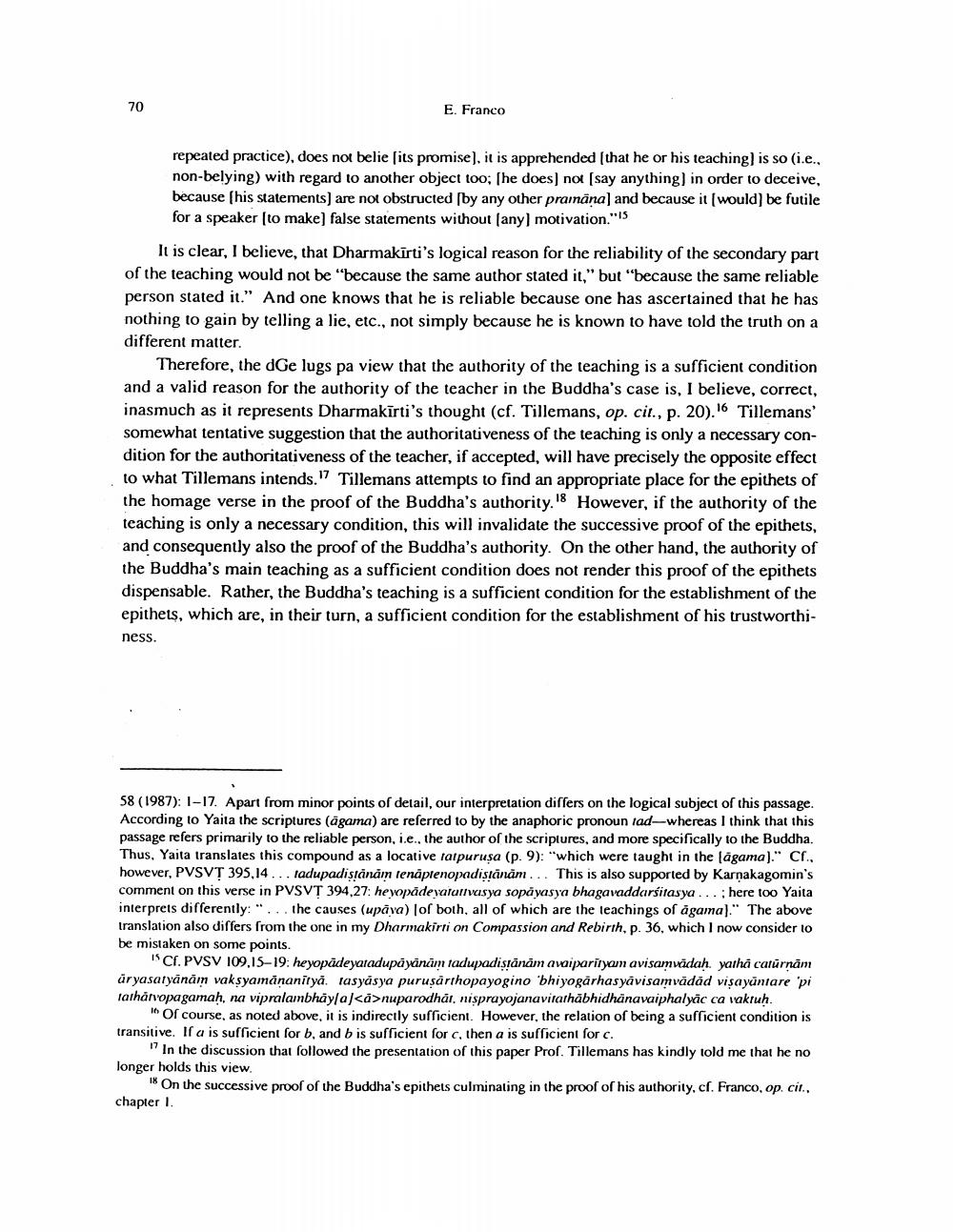Book Title: Two Circles Or Parallel Lines Author(s): Eli Franco Publisher: Eli Franco View full book textPage 8
________________ E. Franco repeated practice), does not belie sits promise), it is apprehended (that he or his teaching) is so (i.e., non-belying) with regard to another object too; she does) not (say anything) in order to deceive, because (his statements are not obstructed by any other pramāna) and because it (would) be futile for a speaker to make) false statements without (any) motivation." It is clear, I believe, that Dharmakirti's logical reason for the reliability of the secondary part of the teaching would not be "because the same author stated it," but "because the same reliable person stated it." And one knows that he is reliable because one has ascertained that he has nothing to gain by telling a lie, etc., not simply because he is known to have told the truth on a different matter. Therefore, the dGe lugs pa view that the authority of the teaching is a sufficient condition and a valid reason for the authority of the teacher in the Buddha's case is, I believe, correct, inasmuch as it represents Dharmakīrti's thought (cf. Tillemans, op. cit., p. 20).16 Tillemans somewhat tentative suggestion that the authoritativeness of the teaching is only a necessary condition for the authoritativeness of the teacher, if accepted, will have precisely the opposite effect to what Tillemans intends." Tillemans attempts to find an appropriate place for the epithets of the homage verse in the proof of the Buddha's authority. However, if the authority of the teaching is only a necessary condition, this will invalidate the successive proof of the epithets, and consequently also the proof of the Buddha's authority. On the other hand, the authority of the Buddha's main teaching as a sufficient condition does not render this proof of the epithets dispensable. Rather, the Buddha's teaching is a sufficient condition for the establishment of the epithets, which are, in their turn, a sufficient condition for the establishment of his trustworthiness. 58 (1987): 1-17. Apart from minor points of detail, our interpretation differs on the logical subject of this passage According to Yaita the scriptures (agama) are referred to by the anaphoric pronoun tad-whereas I think that this passage refers primarily to the reliable person, i.e., the author of the scriptures, and more specifically to the Buddha. Thus, Yaita translates this compound as a locative tatpurusa (p. 9): "which were taught in the lāgama)." Cl., however, PVSVT 395,14... tadupadi stånām tenäptenopadistānăm ... This is also supported by Karnakagomin's comment on this verse in PVSVT 394,27: hevopädevalarivasya sopayasya bhagavaddarsitasya... here too Yaita interprets differently: "... the causes (upaya) (of both, all of which are the teachings of agama)." The above translation also differs from the one in my Dharmakirti on Compassion and Rebirth, p. 36, which I now consider to be mistaken on some points. ISCI. PVSV 109.15-19: heyopädeyatadupāyanām tadupadistānam avaipariryam avisamuādah yarha caturnām aryasatyānām vak syamānanitya. tasyasya purusarthopayogino 'bhiyogárhasyavisamvādad visayuntare pi tathārvopaganah, na vipralambhāyla]<a>nuparodhal, nisprayojanavitathābhidhänavaiphalyac ca vakruh. 16 or course, as noted above, it is indirectly sufficient. However, the relation of being a sufficient condition is transitive. If a is sufficient for b, and b is sufficient for c, then a is sufficient for c. "In the discussion that followed the presentation of this paper Prof. Tillemans has kindly told me that he no longer holds this view. Is On the successive proof of the Buddha's epithets culminating in the proof of his authority, cf. Franco, op. cit.. chapter 1Page Navigation
1 ... 6 7 8 9 10
